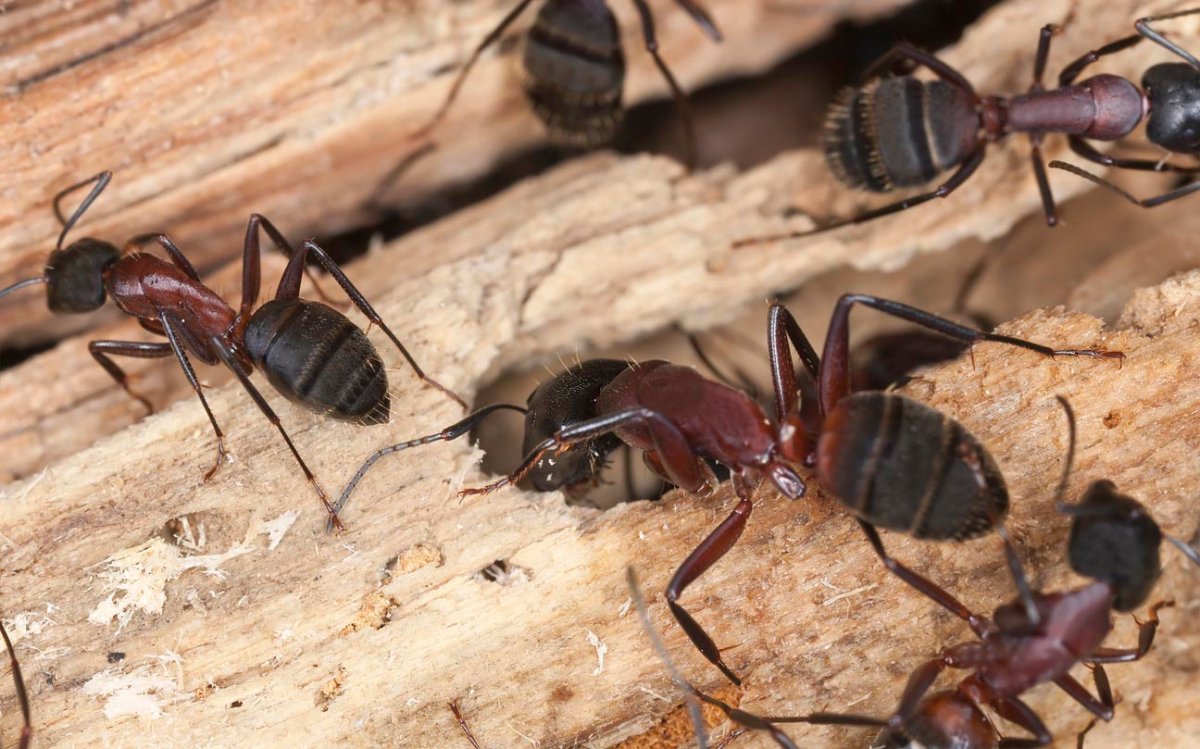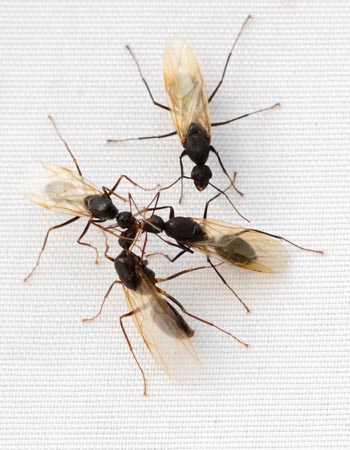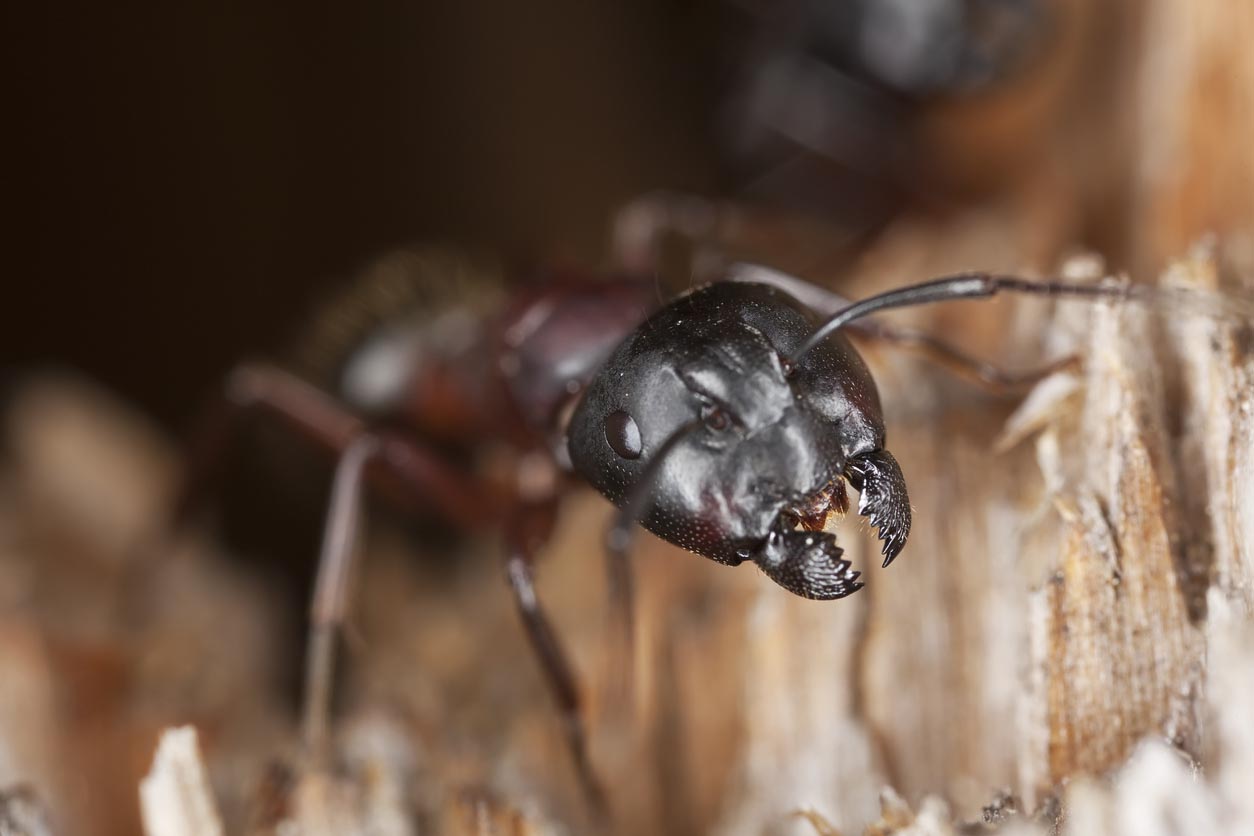

We may earn revenue from the products available on this page and participate in affiliate programs. Learn More ›
Q: I’m noticing some damage to the wood in my home but I’m not sure whether it’s caused by carpenter ants, termites, or something else. What are the signs of carpenter ants in the house, and how can I determine if I have an infestation?
A: Carpenter ants can cause serious damage to wood on properties. Their name originates from how they create their nests. Carpenter ants burrow in wood and build smooth tunnels where they work and live. While they can be mistaken for common black ants, there are distinct differences between the two upon closer inspection.
The presence of carpenter ants can be a sign they’ve created a nest in the home; however, there needs to be further examination to determine if they’ve made a nest in the property or are just passing through for food.
A warning for homeowners: If their activities go unchecked, carpenter ants can cause significant structural damage, and therefore are a threat to the home’s structural integrity. Extermination is time-sensitive, so the sooner the problem is taken care of, the less likely homeowners are to experience serious problems in the future.
Ultimately, being aware of signs of carpenter ants in the house and consulting a top pest control company or expert familiar with carpenter ant infestations can help homeowners determine the best course of action.
Carpenter ants are larger than other types of ants. They can be black or red in color.

At first glance, it can be hard to tell the difference between carpenter ants vs. black ants. However, the differences are more apparent upon closer examination. So what does a carpenter ant look like? According to the Rutgers University Cooperative Extension, carpenter ants can be up to five times larger than other common types of ants, measuring an average of ⅝ of an inch. A carpenter ant can vary in size depending on its role within the colony; for instance, a queen carpenter ant is relatively large compared to worker ants. While there are several varieties of carpenter ants, the characteristic they all share is an arch-shaped thorax. They do not look like termites, which are cream to amber in color with straight bodies.
“Carpenter ants may be identified by a single node between the thorax and abdomen. Other ant species may have two nodes,” adds Jim McHale, an entomologist and CEO and president at JP McHale Pest Management in Buchanan, New York. “Carpenter ants have a rounded or smooth thorax where others are ridged. Carpenter ants will always have an ‘elbowed’ antenna.”
As there are many types of carpenter ants and common ants in the United States, it’s difficult for someone to rely on color to identify the exact species of ant. For reference, black carpenter ants are usually black or dark brown, while red carpenter ants have a red thorax.
Piles of sawdust or wood shavings near baseboards, door jambs, and windowsills can indicate carpenter ants.
According to Howard Russell, an entomologist at Michigan State University, the idea that carpenter ants eat wood is a misconception. “Carpenter ants do not eat wood like termites and powderpost beetles do, and their status as a serious wood-destroying insect is greatly exaggerated,” he explains. Instead, carpenter ants tunnel through damp wood to make their nests. One of the telltale signs of carpenter ant damage is “frass,” which consists of moist wood shavings from damp wood near baseboards, door jambs, and window sills. Frass also contains pieces of other insects carpenter ants have eaten and disposed of. “They prefer wood with a very high moisture content,” says Russell. “When they nest in homes and other structures, they are typically found in areas where there is a significant moisture problem. Carpenter ant nests are often found in sheathing under leaky shingles, in wall voids around bathtubs and shower enclosures that were improperly sealed, in the framing around windows and doors that were improperly flashed and sealed, and other areas where there has been a long-standing water problem.”
It’s a good idea for homeowners to check basements, crawl spaces, and other places on the property with damp wood to see if there is a buildup of frass or sawdust. This can indicate carpenter ants are present and possibly causing structural damage. Carpenter ants are not as damaging as termites; however, they can cause thousands of dollars worth of damage if left unchecked.
Carpenter ants can make rustling or scratching noises in walls or woodwork.
The majority of mature carpenter ant colonies have around 3,000 ants. Larger colonies can host anywhere from 10,000 to 20,000 worker ants and up to 100,000 total carpenter ants. As the colony grows, there’s a greater chance a homeowner will be able to hear them building their nests. According to McHale, “When near a colony, you can sometimes hear them clicking their mandibles together in an effort to scare predators away,” and this sounds like “a light ticking noise.” There may also be a rustling sound as they tunnel through the wood to make their homes. It’s best to listen for this soft rustling sound when it’s quiet, preferably at night. It’s also helpful to test the walls by tapping the structure to see if the wood sounds hollow.
Flying ants or shed wings can be a sign of a carpenter ant infestation.
Another sign of a carpenter ant infestation is the presence of flying ants. Flying ants are reproductive ants within the colony that will leave the nest to reproduce and create new colonies. If there are winged ants on the property, it can indicate an established, mature carpenter ant colony. Since flying ants only make up a portion of the colony, just getting rid of the flying ants is not enough to eliminate the infestation. At this point, the carpenter ants may have caused significant damage that needs to be examined by a professional, and an exterminator will need to be called to control the infestation.
Since these insects are mostly nocturnal, homeowners may not see carpenter ants with wings themselves. However, they might find remnants of shed wings. Wings are most likely to be found on windows or near cracks and crevices, especially in places where piles of frass have also accumulated.

Both termites and carpenter ants damage wood, but the wood that carpenter ants have damaged will be smooth and clean inside, whereas termite damage will have signs of soil and mud inside.
To tell the difference between damage from a termite vs. a carpenter ant infestation, homeowners will want to examine the wood carefully. Wood galleries created by carpenter ants will be smooth and have an almost sandpaper texture to them. There will also be small holes where carpenter ants have kicked out debris, usually varying in size. Alternatively, termite-damaged wood contains soil and mud debris with more uniform sizes. Over time, polished tunnels created by carpenter ants will weaken the structural integrity of the wood in the home, possibly causing the walls to warp from the thousands of holes in the ants’ galleries.
Another way to differentiate between termite vs. carpenter ant damage is that carpenter ants are not likely to target wood that is dry and intact. “Unlike [with] termites, carpenter ant damage is limited to areas with significant moisture problems,” says McHale. “Wood needs to be moist for them to tear the fibers.” Russell agrees: “Carpenter ants do not chew on sound, dry wood, hence the damage they do is not significant. The wood they chew their galleries in is typically water-soaked, rotted, and in need of replacement.” It’s also worth noting that the fact that the damp wood preferred by carpenter ants is already weak from water damage means that damage from the ants may be accelerated.
Carpenter ants can also leave long trails and paths on a home’s lawn.
Carpenter ants live not only inside walls but also outdoors. They often establish routes between their nests and the areas where they forage for food as they travel between these locations frequently. These can look like long, skinny trails that are visible in a lawn’s grass. There isn’t likely to be activity on these trails during the day, but after sunset, the trails may be occupied by hoards of carpenter ants as they go out in search of their evening meal. To look for nests, the University of Georgia Extension Office recommends that homeowners take a look at any nearby trees that are at least 6 inches in diameter shortly after sundown. If carpenter ants have taken up residence in the tree, it will be possible to see them traveling up and down the trunk with bits of food to take back to the nest. It’s worth noting that carpenter ants bite occasionally, so it’s a good idea for the homeowner to wear shoes and long pants in the yard if carpenter ant trails may be present.
Carpenter ants may not be consistently active, but that doesn’t mean that they’re gone.
Since carpenter ants do not eat the wood they live in, homeowners may see carpenter ants emerge from their nests to forage for food. These worker ants can travel up to 300 feet in their search. It’s common for homeowners to only see a few ants at a time, especially if it’s dry and sunny. However, the majority of the time, they may be tending to their nests. It’s possible that homeowners will not see them very often; however, this doesn’t mean they’ve moved on. It’s more likely that they’re further establishing their nest, especially if they’re in a cool or damp environment.

Homeowners can attempt to get rid of a carpenter ant infestation on their own, though a professional exterminator is usually best equipped to deal with a carpenter ant infestation.
Once homeowners have identified the warning signs of carpenter ants living in a home, there are a few carpenter ant treatment measures to help mitigate the issue. “The best method of controlling an indoor colony of carpenter ants is to locate the nest and treat it directly with a persistent insecticide labeled for indoor use,” says Russell. The best carpenter ant killers can be purchased at a hardware or garden store. It may also be worth putting out carpenter ant bait traps with borax or another ant poison as an additional measure.
For those who prefer not to use chemical insecticides, sprinkling diatomaceous earth in areas where carpenter ants have been seen can be effective. This substance is a natural carpenter ant killer that is nontoxic to humans and pets. Finally, homeowners will want to get to the root of the problem by eliminating the damp conditions that attract carpenter ants in the first place. In fact, as Russell states, “The real threat to homeowners is water infiltration, not the ants. The ants often serve as a warning sign of a long-standing water problem.”
If DIY methods aren’t working, or homeowners don’t know how to find a carpenter ant nest, it’s a good idea to contact a professional from one of the best pest control companies like Orkin or Terminix to get the infestation under control. The average cost to hire an ant exterminator for carpenter ants is between $250 and $500, which can be well worth it to ensure that ants are eliminated for good. According to McHale, “A pest professional is valuable in helping you locate the colony. It could be outside, with a satellite colony inside. A number of different scenarios are possible.” A professional exterminator can also ensure that there aren’t any ants left behind after eliminating the colony. Even leaving behind a few ants can allow them to rebuild their colony and reestablish a nest inside the home.
There are several measures a homeowner can take to prevent future carpenter ant infestations.
After getting rid of ants, homeowners will want to prevent future infestations by sealing up any cracks within the home where ants could get through. They’ll also want to get rid of what attracts ants by storing food in airtight containers, cleaning up food scraps promptly, and regularly vacuuming up crumbs. It’s also a good idea for homeowners to move wood piles that are next to the home’s exterior and trim nearby bushes and trees. Most importantly, homeowners will want to ensure there isn’t damp wood in the home that ants can use to build their nests. It’s important for homeowners to stay vigilant about plumbing and roof leaks as well as keep an eye out for condensation around windows. Russell adds, “Foraging carpenter ants are a nuisance to some, and an outside perimeter treatment with a residual insecticide purchased from a local hardware store will usually prevent them from coming inside.”
